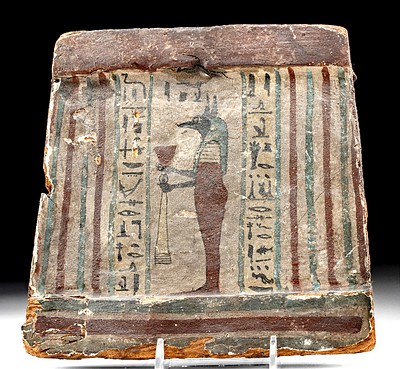Massive Roman Marble Relief - 2 Figures + Child
Lot 26
About Seller
Artemis Fine Arts
686 S Taylor Ave, Ste 106
Louisville, CO 80027
United States
Selling antiquities, ancient and ethnographic art online since 1993, Artemis Gallery specializes in Classical Antiquities (Egyptian, Greek, Roman, Near Eastern), Asian, Pre-Columbian, African / Tribal / Oceanographic art. Our extensive inventory includes pottery, stone, metal, wood, glass and textil...Read more
Categories
Estimate:
$20,000 - $30,000
Absentee vs Live bid
Two ways to bid:
- Leave a max absentee bid and the platform will bid on your behalf up to your maximum bid during the live auction.
- Bid live during the auction and your bids will be submitted real-time to the auctioneer.
Bid Increments
| Price | Bid Increment |
|---|---|
| $0 | $25 |
| $300 | $50 |
| $1,000 | $100 |
| $2,000 | $250 |
| $5,000 | $500 |
| $10,000 | $1,000 |
| $20,000 | $2,500 |
| $50,000 | $5,000 |
| $100,000 | $10,000 |
| $200,000 | $20,000 |
About Auction
By Artemis Fine Arts
Aug 26, 2021
Set Reminder
2021-08-26 10:00:00
2021-08-26 10:00:00
America/New_York
Bidsquare
Bidsquare : Fine Antiquities | Asian | Ethnographic Art
https://www.bidsquare.com/auctions/artemis-gallery/fine-antiquities-asian-ethnographic-art-7366
Features classical antiquities, ancient and ethnographic art from cultures encompassing the globe. Egyptian, Greek, Roman, Etruscan, Near Eastern, Asian, Pre-Columbian, Native American, African / Tribal, Oceanic, Spanish Colonial, Russian, Fine / Visual Arts, so much more! Artemis Fine Arts info@artemisgallery.com
Features classical antiquities, ancient and ethnographic art from cultures encompassing the globe. Egyptian, Greek, Roman, Etruscan, Near Eastern, Asian, Pre-Columbian, Native American, African / Tribal, Oceanic, Spanish Colonial, Russian, Fine / Visual Arts, so much more! Artemis Fine Arts info@artemisgallery.com
- Lot Description
Roman, Imperial Period, ca. 1st to 3rd century CE. A marvelous and massive stone relief depicting 2 male figures and a child, all draped in chitons and standing contrapposto with each of their weight on the left leg. All 3 of the figures are posed similarly, each with the right arm folded over the chest and right hand placed over the heart, as the left arm hangs to the side, gently bent at the elbow and the left hand rests above the thigh. Both hands of each figure seem to be touching the hems of their chitons. The figure to the left gazes outward from deep-set eyes beneath a furrowed brow. His face shows signs of age with a bulbous nose, prominent nasolabial folds, and a thin mouth, all topped by a shortly cut coiffure. The child stands below the right figure, also wearing a short coiffure. Size: 35.25" L x 12" W x 72" H (89.5 cm x 30.5 cm x 182.9 cm); 79" H (200.7 cm) on included custom stand.
This example may represent a family; such reliefs were often commissioned by recently enfranchised slaves and their families as a way of establishing the social and familial identity and relationships that had been legally denied to them.
Marble statuary, reliefs, and cladding were ubiquitous in the Roman world, as the remains of the preserved cities at Herculaneum and Pompeii demonstrate. Their sculpture was intended to conjure human vitality, and was inspired by the works of Polykleitos, who became the model to which sculptors aspired in Greco-Roman as well as later Western European art. Greco-Roman statuary, unlike that of the other Mediterranean civilizations like Egypt, Persia, etc., celebrated the naturalistic human form. This included representations of their gods, who appear as if living people, dressed as if they are elite citizens. For example, the famous statue of Hades with Cerberus, his three-headed dog, today on display at the Archaeological Museum of Crete, has an extremely realistic quality despite its fantastical nature, down to the details on each dog head. This suggests an intriguing, more personal relationship with the gods rather than the more abstract or magical portrayals of other contemporary societies.
This item is oversized and/or heavy, and may require special crating and freight shipment. Please inquire for a quote prior to bidding.
This piece has been searched against the Art Loss Register database and has been cleared. The Art Loss Register maintains the world's largest database of stolen art, collectibles, and antiques.
Provenance: private West Hollywood, California, USA collection; ex-Ruth Westreich collection, Rancho Santa Fe, California, USA, acquired on the London art market and imported into the US in 1985
All items legal to buy/sell under U.S. Statute covering cultural patrimony Code 2600, CHAPTER 14, and are guaranteed to be as described or your money back.
A Certificate of Authenticity will accompany all winning bids.
PLEASE NOTE: Due to recent increases of shipments being seized by Australian & German customs (even for items with pre-UNESCO provenance), we will no longer ship most antiquities and ancient Chinese art to Australia & Germany. For categories of items that are acceptable to ship to Australia or Germany, please contact us directly or work with your local customs brokerage firm.
Display stands not described as included/custom in the item description are for photography purposes only and will not be included with the item upon shipping.
#166695Dimension
Weight: 1500.00 lbsFragment of a larger piece. Loss to one side of face on proper left figure. Indentation with some loss on proper right leg of proper right figure. Expected nicks, abrasions, and softening of detail throughout. Otherwise, excellent.Condition
- Shipping Info
-
All shipping is handled in-house for your convenience. Your invoice from Artemis Gallery will include shipping calculation instructions. If in doubt, please inquire BEFORE bidding for estimated shipping costs for individual items.
-
- Buyer's Premium



 EUR
EUR CAD
CAD AUD
AUD GBP
GBP MXN
MXN HKD
HKD CNY
CNY MYR
MYR SEK
SEK SGD
SGD CHF
CHF THB
THB


















